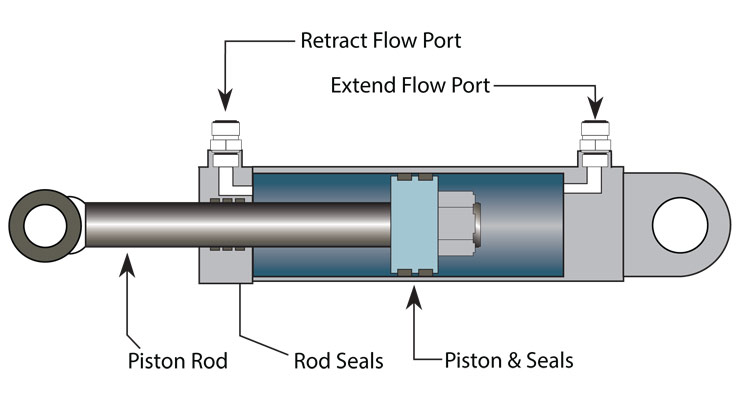Hydraulic cylinders are a fundamental part of modern machinery, providing the necessary driving force for a wide range of operations in industrial, construction and agricultural applications. The piston rod is the core component of the hydraulic cylinder and plays a vital role in the transmission of power in the hydraulic system.

The hydraulic cylinder is made up of several fundamental parts, each with a unique role in transforming hydraulic energy into mechanical force. These key components comprise:
•The cylinder itself, which retains the hydraulic fluid.
•The cylinder base or cap, which secures one end of the cylinder.
•The cylinder head, sealing off the opposite end of the cylinder.
•The piston, which reciprocates internally within the cylinder.
•The piston rod extends from the piston, passes through the cylinder head, and connects with the mechanical element that performs the task.
Notably, the piston rod holds immense importance as it bridges the hydraulic actuation system with the mechanical operation being carried out. As hydraulic fluid is introduced into the cylinder, it displaces the piston, leading to the movement of the piston rod. In the context of the vast majority of hydraulic cylinders, this motion is linear, effectively converting hydraulic pressure into mechanical energy utilized for a broad spectrum of applications, spanning from elevating hefty burdens to executing precise control actions in manufacturing processes.
Piston rods are customarily fabricated from high-strength steel alloys, meticulously selected due to their resilience, resistance to abrasion, and capacity to bear significant stresses and pressures. Predominant materials encompass chromium-molybdenum steel, renowned for its superior strength-to-weight ratio, and stainless steel, which is preferred in settings where resistance to corrosion is vital. The material selection directly influences the piston rod's efficacy, service life, and appropriateness for particular applications.
The fabrication procedure of piston rods entails meticulous engineering to guarantee adherence to stringent tolerance and excellence criteria. Initiated by the measurement and cutting of the steel alloy to the designated length, the process progresses to machining for attaining the exact diameter and surface finish necessities. Heat treatment is a common practice incorporated to augment strength and longevity. Concludingly, the rods generally undergo chrome plating, an indispensable phase that bolsters their defense against wear and corrosion, thereby prolonging their functional lifespan amidst hostile conditions.
Ensuring piston rod integrity is essential for the hydraulic cylinder's peak performance and reliability. Any deterioration can spark a chain of problems, impacting not only the cylinder's effectiveness but also its safety and service life. Scratches, corrosion, or bending of the rod can undermine the piston-to-barrel seal, resulting in leaks, diminished output, and potential system breakdown.
Furthermore, the piston rod's surface condition directly governs seal durability. A sleek, durable, corrosion-proof surface optimizes seal lifespan and sustains hydraulic efficiency. Conversely, a faulty or substandard rod escalates friction, precipitating early seal failure and hydraulic fluid contamination, intensifying system degradation.
Preventative maintenance is key to ensuring the longevity and reliability of hydraulic cylinders and their components, especially piston rods. By implementing a proactive approach, many common issues can be prevented, thereby minimizing downtime and repair costs.
The cornerstone of preventative maintenance is establishing regular inspection and maintenance schedules. Consistent inspections can detect early signs of wear, corrosion, surface damage, or misalignment before they develop into more serious issues. A maintenance schedule should include:
1.Cleaning: Keep piston rods free from dirt, debris, and contaminants that can cause wear or corrosion. Cleaning also allows for closer inspection of the surface.
2.Lubrication: Ensure all moving parts, especially those in contact with piston rods, are properly lubricated to minimize friction and wear.
3.Seal Replacement: Replace seals regularly or at the first sign of wear to prevent leaks and contamination.
Applying protective coatings and treatments to piston rods can significantly extend their life by safeguarding against corrosion, erosion, and wear. Consider the following options:
1.Hard Chrome Plating: A popular choice for piston rods, offering excellent resistance to wear and corrosion. It also provides a smooth surface that minimizes friction on seals.•Nickel-Chrome Plating: Provides enhanced corrosion resistance, making it suitable for harsh environments.
2.Ceramic Coatings: Offer superior hardness and resistance to wear and corrosion, ideal for extreme conditions.
3.Laser Cladding: A method to apply high-performance coatings that bond with the base material, enhancing durability and resistance.
Proper operation and storage of hydraulic systems are crucial for preventing damage to piston rods:
1.Avoid Overloading: Operate machinery within its specified capacity limits to prevent bending and stress on piston rods.
2.Smooth Operation: Ensure hydraulic systems operate smoothly to avoid shocks and impacts that can cause damage.
3.Proper Storage: When not in use, store equipment in a clean, dry environment to prevent corrosion. Use rod covers or retract piston rods to protect them from environmental exposure.
4.Hydraulic Fluid Management: Regularly check and replace hydraulic fluid to prevent contamination that can lead to erosion or corrosion of piston rods.
Maintaining the integrity of the piston rod is critical to the efficient and reliable operation of the hydraulic system. Any deterioration in the condition of these components will result in reduced system performance, increased wear on other components, and possible costly downtime. In short, the health of the piston rod is critical to the smooth operation of the hydraulic system.